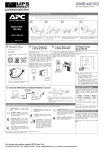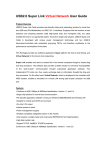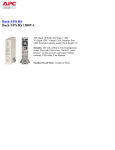Download Manual - Videcon
Transcript
Installation 1 Placement / Power Avoid placing the Back-UPS in: ® • Direct sunlight • Excessive heat • Excessive humidity or in contact with fluids of any type Back-UPS™ CS 350/500 Plug the Back-UPS into a wall outlet, as shown. User’s Manual 3 Connect the Phone 2 Connect Equipment to the Back-UPS Line to Surge Protection The rear panel of the Back-UPS consists of the following elements: The telephone ports provide lightning surge protection for any device connected to the telephone line (computer, modem, fax or telephone). The telephone ports are compatible with Home Phoneline Networking Alliance (HPNA) and Digital Suscriber Line (DSL) standards, as well as all modem data rates. Connect as shown. Battery Back Up Outlets (qty. of 3). These outlets provide battery back-up, surge protection, and Electro-magnetic Interference (EMI) filtering. In case of power outage, battery power is automatically provided to these outlets. Power (utility or battery) is not supplied to these outlets when the Back-UPS is switched Off. Connect a computer, monitor, and external disk or CD-ROM drive to these outlets. Wall Outlet Surge Only Outlet. This outlet is always On (when utility power is available) and is not controlled by the On/Off switch. This outlet does not provide power during a power outage. Connect a printer, fax machine or scanner to this outlet. Modem/Phone/Fax 990-2085 2/01 Your computer’s power cord. • The Back-UPS charges the internal battery any time it is connected to a wall outlet. 4 Switch on the Back-UPS Note: Allow the Back-UPS to charge for a full eight hours prior to use. Press the push-button on the front panel of the BackUPS. 5 Connect USB Cable and Install Software (optional) Note: The Back-UPS software CD-ROM provides data reporting and unattended shutdown of computers connected to the device. The User’s Guide contains additional information about the Back-UPS software. The User’s Guide is contained in the main folder with the CD-ROM. Attention: USB Hubs ON LINE ON BATTERY OVERLOAD REPLACE BATTERY The Back-UPS should be plugged into the USB port of the computer, not into a USB hub. The computer must be powered On before connecting the USB cable. Connect the USB cable end (USB symbol facing down) to the rear panel USB port of the Back-UPS. Connect the other end of the USB cable to the USB port (usually located on the rear panel of the computer). Windows 98® and Windows Me® Users Observe that the following events occur after pressing and releasing the push-button: • The green On-Line indicator flashes. • The yellow On Battery indicator lights while the Self-Test is being performed. • When Self-Test has successfully completed, only the green On Line indicator will be lit. • If the internal battery is not connected, (see Step 1 above) the green On Line indicator and red Replace Battery indicator will light. The BackUPS will also emit a chirping sound. The APC Power Management Extensions software has been designed specifically to work with Windows 98 build number 4.10.1998, Windows 98 SE (Second Edition) 4.10.2222A, and Windows Me (Millennium Edition). To ascertain the build number, go to the Control Panel, open the System dialog and view the System information under the General tab of the dialog. To install the software, perform the following steps: 1. Please skip to step 4 if running Windows Me. For Windows 98, after connecting the USB cable, the “Add New Hardware Wizard” dialog box is displayed. Insert a Windows 98 operating system CD into the computer CDROM drive before proceeding. 2. Follow the installation instructions on the computer screen. During installation, Windows will need to search for new drivers. When prompted, make sure the CD-ROM drive box is checked. ON LINE Overload (red) - is lit whenever power demand has exceeded the capacity of the Back-UPS. REPLACE BATTERY On Line (green) - is lit whenever utility power is powering the Battery Backup outlets. On Battery (yellow) - is lit whenever the battery of the Back-UPS is powering equipment connected to the Battery Backup Outlets. Four Beeps Every 30 Seconds - this alarm is sounded whenever the BackUPS is running On Battery. Consider saving work in progress. Continuous Beeping - this alarm is sounded whenever a low battery condition is reached. Battery run-time is very low. Promptly save any work in progress and exit all open applications. Shutdown the operating system, computer and the Back-UPS. The CD-ROM included with this package contains a “wizard” that optimizes a computer system’s power settings for operation with the Back-UPS. It does this by changing various settings in Power Options Properties in the Control Panel. APC strongly advises that the computer system be reconfigured by running this wizard. 1. Insert the APC Power Management CD-ROM into the computer’s drive. APC Shutdown Manager software has been designed specifically to work with Mac OS 9 (9.0.4 or higher, except OS X). There are builds of the Mac OS prior to Mac OS 9.0.4 with power drivers that have known problems. Ensure that the most up to date version of Mac OS 9 (9.0.4 or higher) is installed on the system. Insert the APC Installation CD-ROM with the APC Shutdown Manager software into the CD-ROM drive. An icon called “APC Shutdown Manager v1.0” will appear on the computer desktop. Open the folder and double-click the “ReadMe” file. Ensure that the computer’s hardware matches the requirements stated in the ReadMe file. Double-click on “APC Shutdown Manager v1.0” to begin the installation of the software. At the first dialog, click on “Continue”. Read the displayed license agreement and click “Accept” to agree to the terms. Click on “Install” to begin. After installation, click on the “Restart” dialog button to restart the computer. All Other Users The software is designed for the Windows Macintosh operating systems mentioned in section. If one of these operating systems is installed on the computer, the Back-UPS will provide these primary features: and this not still • Battery backup, surge protection, and telephone line protection to protect the entire desktop from lightning and power surges. • Runtime needed to work through brief power disturbances. This allows time to manually save data and shut down safely. The disabled features include Unattended Automatic Operating System Shutdown and Application Data Saving. 2. Choose “Start” and then the “Run” option. Type: <CD-ROM drive letter>:\setup.exe. To replace the internal battery, proceed as follows: Note: Continuous Tone - this alarm is sounded whenever the Battery Backup outlets are overloaded. ON BATTERY OVERLOAD Windows 2000® Users Mac OS 9 (9.0.4 or higher) Users Replace the Internal Battery Status Indicators and Alarms There are four status indicators (lights) on the front panel of the Back-UPS (On Line, On Battery, Overload, and Replace Battery). 3. After installation of the drivers is complete, a “Windows 98 CD-ROM” dialog box may appear. If this happens, just close the box. 4. Insert the APC Installation CD-ROM into the computer’s drive. The software user documentation is a file on the main folder of the CD. The filename is Users Guide.pdf. 5. Follow the installation instructions on the computer screen. If the software does not automatically install, the Windows autorun feature may have been disabled. In this case: Choose “Start” in the taskbar and then the “Run” option. Type the following: <CD-ROM drive letter>:\setup.exe. Click “OK”. 6. After the installation is complete, the APC plug icon will appear in the taskbar (near the clock). To view the Power Management user interface, double-click on the APC plug taskbar icon or, alternatively, choose: Start > Settings > Control Panel > Power Management. Note: Windows 98 and Windows Me categorize a UPS as an HID (Human Interface Device). The Back-UPS is listed in: Control Panel > System > Device Manager > HID category > HID Compliant Device. Replacing the battery is a safe procedure. However, small sparks may occur during the process. This is normal. 1 2 Place the unit on its side. Slide the battery compartment cover upward and off of the UPS. Pull the battery out, exposing the battery terminals and wires. Disconnect the wires from the terminals. 3 4 Circuit Breaker - the circuit breaker button located on the rear panel of the Back-UPS will stick out if an overload condition forces the Back-UPS to disconnect itself from utility power. If the button sticks out, disconnect nonessential equipment. Reset the circuit breaker by pushing the button inward. Replace Battery (red) - is lit when- ever the battery is near the end of its useful life, or if the battery is not connected (see above). A battery that is near the end of its useful life has insufficient runtime and should be replaced. Chirps for 1 Minute Every 5 Hours this alarm is sounded whenever the battery has failed the automatic diagnostic test. Slide the new battery into the battery compartment. Align the battery compartment cover with the grooves Connect the battery wires to the terminals as follows: in the UPS. Slide the cover down until it locks. Black wire to Ground (-) terminal Red wire to Positive (+) terminal APC, Back-UPS, and PowerChute plus are registered trademarks of American Power Conversion. All other trademarks are property of their respective owners. Troubleshooting Transfer Voltage Adjustment (optional) Use the tables below to solve minor Back-UPS installation and operation problems. Consult APC On-line Technical Support or call APC Technical Support for assistance with problems that cannot be resolved using this document: In situations where the Back-UPS or connected equipment appears too sensitive to input voltage, it may be necessary to adjust the transfer voltage. This is a simple task requiring use of the front panel pushbutton. To adjust the transfer voltage, proceed as follows: 1. Plug the Back-UPS into the utility power source. The Back-UPS will be in a Standby Mode (no indicators lit). 2. Press the front panel pushbutton fully inward for 10 seconds. All indicators on the Back-UPS will flash to acknowledge going into Programming Mode. 3. The Back-UPS will then indicate its current Lower Transfer Voltage, as shown in the following table. Possible Cause Procedure Back-UPS will not switch on Back-UPS not connected to an AC power source. Back-UPS circuit breaker “tripped”. Very low or no utility voltage. Check that the Back-UPS power plug is securely connected to the wall outlet. Disconnect non-essential equipment from the Back-UPS. Reset the circuit breaker (located on the rear panel of the Back-UPS) by pushing the circuit breaker button fully inward until it catches. If the circuit breaker resets, switch the Back-UPS on and reconnect the equipment one-at-a-time. If the circuit breaker trips again, it is likely that one of the connected devices is causing the overload. Check the wall outlet that supplies power to the Back-UPS using a table lamp. If the lamp bulb is very dim, have the utility voltage checked by a qualified electrician. 4. 5. 6. 7. Indicators Lit Lower Transfer Voltage 1 160 VAC 2 3 180 VAC (factory default) 196 VAC Computer, monitor or external disk/ CD-ROM drive is plugged into a Surge Only outlet. Back-UPS Storage Before storing, charge the Back-UPS for at least eight hours. Store the Back-UPS covered and upright in a cool, dry location. During storage, recharge the battery in accordance with the following table: Storage Temperature Back-UPS operates on battery although normal utility voltage exists Back-UPS circuit breaker “tripped”. -5o to 30oC (23o to 86oF) Check the battery connections. (See “Connect the Battery” under “Installation” on the front page of this document. Move computer, monitor, or external drive power cord plug to the Battery Backup outlets. Back-UPS battery is weak due to recent outage and has not had time to recharge. Charge the battery. The battery charges whenever the Back-UPS is connected to a wall outlet. Typically, eight hours of charging time are needed to fully charge the battery from total discharge. Back-UPS run-time is reduced until the battery is fully charged. Battery requires replacement. Replace battery (see Order Replacement Battery). Batteries typically last 3-6 years, shorter if subjected to frequent power outages or elevated temperatures. A red indicator is lit Battery is not connected properly. Check the battery connections. Consult "Connect the Battery" under "Installation" on the front page of this document. It shows how to access the battery and connect the wires. The Overload indicator is lit if equipment connected to the Battery Backup outlets is drawing more power than the Back-UPS can provide. Move one or more equipment power plugs to the Surge Only outlets. Battery requires replacement. The battery should be replaced within two weeks (see "Order Replacement Battery"). Failure to replace the battery will result in reduced run-time during a power outage. 1. 2. 4. Note: Never use StyrofoamTM beads for packaging. Damage sustained in transit is not covered under warranty (insuring the package for full value is recom5. 6. Write the RMA# on the outside of the package. Return the UPS by insured, prepaid carrier to the address provided by customer service. Warranty The standard warranty is two (2) years from the date of purchase. APC’s standard procedure is to replace the original unit with a factory reconditioned unit. Customers who must have the original unit back due to assigned asset tags and set depreciation schedules must declare such a need at first contact with an APC Technical Support representative. APC will ship the replacement unit once the defective unit has been received by the repair department, or cross ship upon the receipt of a valid credit card number. The customer pays for shipping the unit to APC. APC pays ground freight transportation costs to ship the replacement to the customer. APC Contact Information Check the battery connections. 1 4 7 * Specifications Input Voltage (on line) Mexico 292.0253 / 292.0255 2 5 8 0 3 6 9 # Brazil 0800.12.72.1 Worldwide 1.401.789.5735 Internet http:\\www.apc.com Technical Support http:\\www.apc.com/support 47 - 63 Hz (autosensing) On Battery Waveshape Stepped Sine Wave 350 VA - 210 W 500 VA - 300 W Typical Recharge Time 8 Hours Operating Temperature 0o to 40oC (32o to 104oF) Storage Temperature -5o to 45oC (23o to 113oF) Operating and Storage Relative Humidity 0 to 95% non-condensing Size (H x W x D) 1.800.800.4272 180 - 264 Vac (default setting) Frequency Limits (on line) Maximum Load USA/Canada Call APC for service. Replace Battery indicator lit and an alarm sounds when the Back-UPS is turned on Internal battery not connected. 8 hours Consult the Troubleshooting section to eliminate common problems. Determine if the circuit breaker is tripped. If the circuit breaker is tripped, reset the breaker and determine if the problem still exists. If the problem persists, consult the APC Worldwide Web site (www.apcc.com) or call customer service. • Record the model number of the UPS, the serial number, and the date purchased. Be prepared to troubleshoot the problem over the telephone with a technician. If this is not successful, the technician will issue a Return Merchandise Authorization Number (RMA#) and a shipping address. • If the UPS is under warranty, repairs are free. If not, there is a repair charge. Pack the UPS in its original packaging. If the original packing is not available, ask customer service about obtaining a new set. Pack the UPS properly to avoid damage in transit. Red indicators are flashing Back-UPS failure. 8 hours Note: If the UPS requires service, do not return it to the dealer. The following steps should be taken: 3. Unplug non-essential Battery Backup connected equipment, such as printers and plug them into Surge Only outlets. Note: Devices that have motors or dimmer switches (laser printers, heaters, fans, lamps, and vacuum cleaners, for example) should not be connected to the Battery Backup outlets. Every 6 months 30o to 45oC (86o to 113oF) Every 3 months Service Back-UPS does not provide expected backup time Back-UPS is excessively loaded. Recharge Frequency Charging Duration Please contact APC Technical Support to troubleshoot the unit before returning it to APC. Disconnect non-essential equipment from the Back-UPS. Reset the circuit breaker (located on the rear panel of the Back-UPS) by pushing the circuit breaker button fully inward until it catches. The wall outlet that the Back-UPS is Connect the Back-UPS to another wall outlet or have a qualified connected to does not supply utility electrician check the building wiring. power to the unit. Normal power conditions exist. Connected equipment is sensitive to low voltage. To select 160 volts as the Lower Transfer Voltage, press the pushbutton until 1 indicator is flashing. To select 180 volts as the Lower Transfer Voltage, press the pushbutton until 2 indicators are flashing. To select 196 volts as the Lower Transfer Voltage, press the pushbutton until 3 indicators are flashing. Once in Programming Mode, if the pushbutton is not pressed within 5 seconds, the Back-UPS will exit the Programming Mode, and all indicators will extinguish. Back-UPS does not power computer/monitor/external drive during an outage Internal battery is not connected. Use When Back-UPS frequently goes On Battery due to low input voltage. 16.5 x 9.2 x 28.5 cm (6.5 x 3.6 x 11.2 inches) Weight 350 VA - 6.3 kg (13.8 lbs) 500 VA - 13.8 lb (6.3 kg) Shipping Weight 350 VA - 7.0 kg (15.3 kg) 500 VA - 15.3 lb (7.0 kg) EMI Classification EN 55022, IEC 801-2 and 801-4 (level IV), and IEC 801-3 (level III) On Battery Run-Time 20 Minutes typical - desktop computer and 15 inch (38.1 cm) monitor. Order Replacement Battery The typical battery lifetime is 3-6 years (depending on the number of discharge cycles and operating temperature). A replacement battery can be ordered over the phone from APC, or the battery can be ordered on-line from the APC web site (see below, a valid credit card is required). When ordering, please specify Battery Cartridge RBC2. Copyright © 2000 American Power Conversion. All rights reserved.























